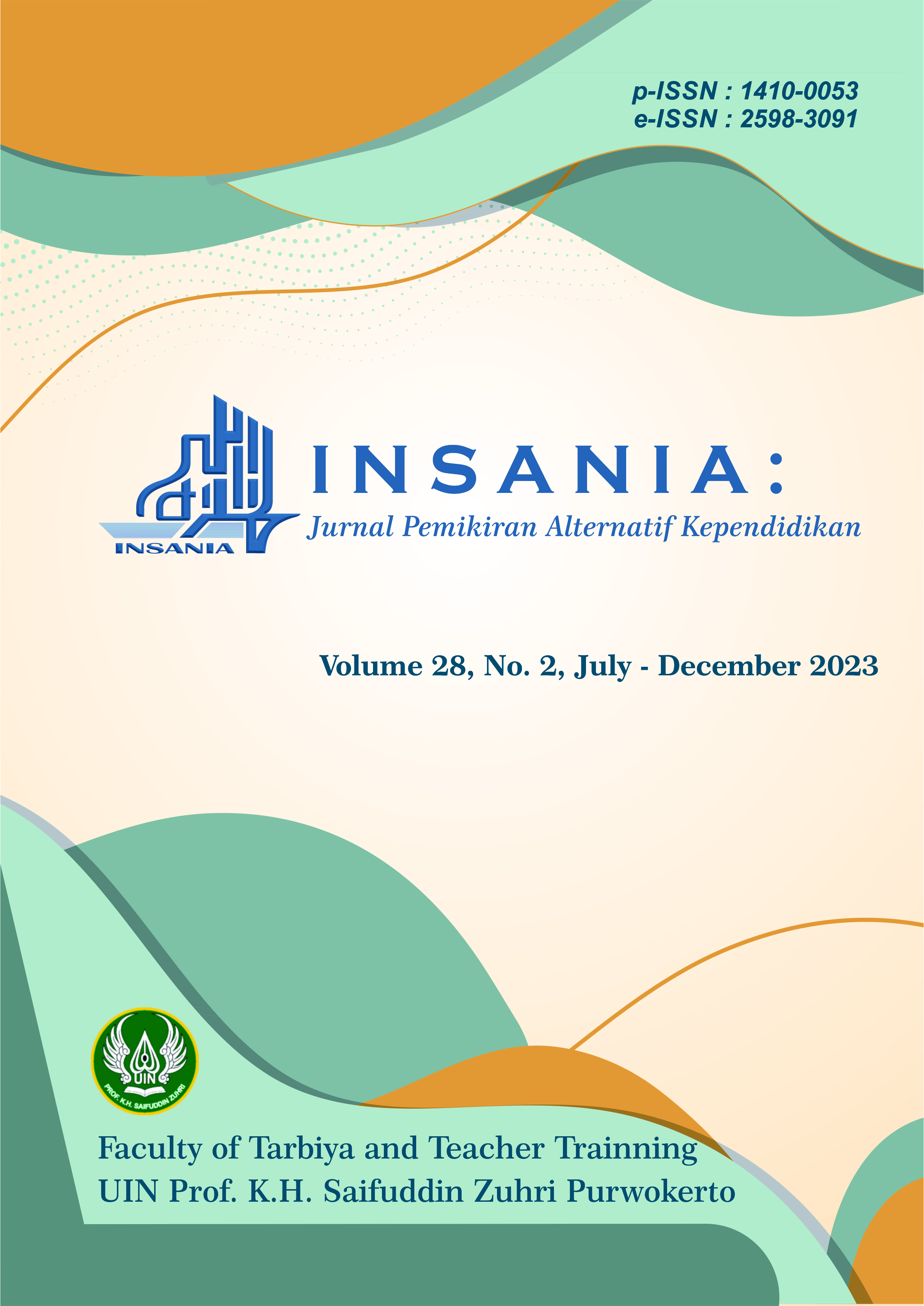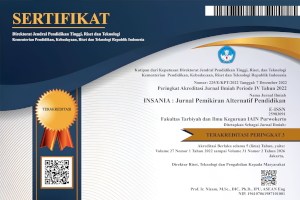Comparison of distance and blended learning models on UIN Saizu Purwokerto students' learning outcomes
DOI:
https://doi.org/10.24090/insania.v28i2.8434Kata Kunci:
Kata kunci: Blended Learning; Capaian Pembelajaran; Efektivitas; Pembelajaran Jarak Jauh.Abstrak
The case of the Covid-19 pandemic led to a government policy to enforce online learning with distance learning and blended learning models. Lecturers are required to present learning innovations using these two models to continue to achieve maximum learning outcomes and student learning outcomes. It is through the implementation of distance learning that students can study anywhere. The blended learning model is innovative and collaborates offline/face-to-face lectures with online lectures. With the implementation of this online learning system, both distance learning and blended learning have differences in student learning outcomes. This study aims to determine the differences in student learning outcomes using distance learning and blended learning models regarding cognitive, affective, and psychomotor aspects. The research method used in this study is quantitative, with a research design using a comparative test to compare learning outcomes between two groups with different treatments. One group uses distance learning, and one group uses blended learning. The data analysis technique used to answer the hypothesis of this research is a statistic with different/comparative test, the t-test with statistical test Kolmogorov Test and Shapiro-Wilks Test to determine normality test and homogeneity test, and a nonparametric test using the Mann-Whitney test. The results showed no significant difference in cognitive, affective (activeness), and psychomotor learning achievement between students who learned to use the distance learning and blended learning models. Significant differences in learning achievement only occur in the affective aspect, particularly in student discipline in learning. Students who learn to use blended learning have better discipline than those who use distance learning.Unduhan
Referensi
Abdullah, W. (2018). Model Blended Learning dalam Meningkatkan Efektifitas Pembelajaran. Fikrotuna, 7(1), 855–866. https://doi.org/10.32806/jf.v7i1.3169
Anshori, F. A, & Syam, S. (2019). Perbandingan Hasil Belajar Mahasiswa Yang Menggunakan E-Learning Berbasis Edmodo Dengan Yang Tidak Menggunakan E-Learning. Biogenerasi: Jurnal Pendidikan Biologi, 4(1), 1–5. https://e-journal.my.id/biogenerasi/article/view/50
Banggur, M. D. V, Situmorang, R., & Rusmono, R. (2018). Pengembangan pembelajaran berbasis blended learning pada mata pelajaran etimologi multimedia. JTP-Jurnal Teknologi, 20(2), 152–165. https://doi.org/10.21009/jtp.v20i2.8629
Ducharme, J. (2020, March 11). World Health Organization Declares COVID-19 a ‘Pandemic.’ Here’s What That Means. Time. https://time.com/5791661/who-coronavirus-pandemic-declaration/
Dziuban, C., Graham, C. R., Moskal, P. D., Norberg, A., & Sicilia, N. (2018). Blended learning: the new normal and emerging technologies. International Journal of Educational Technology in Higher Education, 15(30), 1-16. https://doi.org/10.1186/s41239-017-0087-5
Fadhilaturrahmi, F., Ananda, R., & Yolanda, S. (2021). Persepsi Guru Sekolah Dasar terhadap Pembelajaran Jarak Jauh di Masa Pandemi Covid 19. Jurnal Basicedu, 5(3), 1683–1688. https://doi.org/10.31004/basicedu.v5i3.1187
Fandianta, F., Sanjaya, G. Y., & Widyandana, W. (2013). Meningkatkan Pengetahuan Mahasiswa Dengan Memberikan Fleksibilitas Belajar Melalui Metode Blended learning. Jurnal Pendidikan Kedokteran Indonesia, 2(2), 1–8. https://doi.org/10.22146/jpki.25178
Gunawan, Y. I. P., & Amaludin, A. (2021). Pemanfaatan Teknologi Pembelajaran Dalam Jaringan Di Masa Pandemi Covid-19. Jurnal Madaniyah, 11(2), 133-150. https://journal.stitpemalang.ac.id/index.php/madaniyah/article/view/195
Hamzah, S. H. (2012). Aspek Pengembangan Peserta Didik: Kognitif, Afektif, Psikomotorik. Dinamika Ilmu, 12(1), 1–22. https://doi.org/10.21093/di.v12i1.56
Hasbullah, H. (2014). Blended Learning, Trend Strategi Pembelajaran Matematika Masa Depan. Formatif: Jurnal Ilmiah Pendidikan MIPA, 4(1), 65–70. http://dx.doi.org/10.30998/formatif.v4i1.140
Isti’anah, A. (2017). The Effect of Blended Learning to the Students' Achievement in Grammar Class. Indonesian Journal of English Education, 4(1), 16–30. https://doi.org/10.15408/ijee.v4i1.5697
Khoiroh, N. (2017). Pengaruh model pembelajaran blended learning dan motivasi belajar terhadap hasil belajar siswa kelas VIII SMPN 1 Gumukmas. Jurnal Penelitian Ilmu Pendidikan, 10(2), 97-110. http://dx.doi.org/10.21831/jpipfip.v10i2.13986
Maskar, S., Dewi, P. S., & Puspaningtyas, N. D. (2020). Online Learning & Blended Learning: Perbandingan Hasil Belajar Metode Daring Penuh dan Terpadu. Jurnal Prisma, 9(2), 154-166. https://doi.org/10.35194/jp.v9i2.1070
Noviansyah, N. (2015). Pembelajaran Bauran Blended Learning Terampil Memadukan Keunggulan Pembelajaran Face-to-Face, E-Learning Offline-Online dan Mobil Learning. At-Turats, 9(2), 75. https://doi.org/10.24260/at-turats.v9i2.318
Pengelola Web Kemendikbud. (2020, November 20). Pemerintah Daerah Diberikan Kewenangan Penuh Tentukan Izin Pembelajaran Tatap Muka. Kementerian Pendidikan dan Kebudayaan Republik Indonesia. https://www.kemdikbud.go.id/main/blog/2020/11/pemerintah-daerah-diberikan-kewenangan-penuh-tentukan-izin-pembelajaran-tatap-muka
Puspitorini, F. (2020). Strategi pembelajaran di perguruan tinggi pada masa pandemi Covid-19. Jurnal Kajian Ilmiah, 1(1), 99–106. https://doi.org/10.31599/jki.v1i1.274
Rahmadani, R., Sari, R. D., Maulana, B., Mendoza, M. D., & Putri, T. T. A. (2022). Penerapan Metode Flex Blended Learning pada SMKS Imelda. Jurnal Teknologi Pendidikan, 15(2), 90–94. https://doi.org/10.24114/jtp.v15i2.39121
Ramadhani, S. P. (2020). Pengaruh Blanded Learning terhadap Hasil Belajar Matakuliah Bimbingan Konseling Mahasiswa PGSD. Jurnal Basicedu, 4(2), 327–336. https://doi.org/10.31004/basicedu.v4i2.350
Sari, A. R. (2013). Strategi Blended Learning Untuk Peningkatan Kemandirian Belajar Dan Kemampuan Critical Thinking Mahasiswa di Era Digital. Jurnal Pendidikan Akuntansi Indonesia, 11(2), 32–43. https://doi.org/10.21831/jpai.v11i2.1689
Sepfiatin, N., & Mahendra, G. K. (2022). Evaluasi Kebijakan Ppkm Darurat Covid-19 Dalam Perspektif LHKP PP Muhammadiyah. TheJournalish: Social and Government, 3(3), 198-206. https://doi.org/10.55314/tsg.v3i3.279 3, 198–206
Setiawan, R., Mardapi, D., Pratama, A., & Ramadan, S. (2019). Efektivitas blended learning dalam inovasi pendidikan era industri 4.0 pada mata kuliah teori tes klasik. Jurnal Inovasi Teknologi Pendidikan, 6(2), 148–158. https://doi.org/10.21831/jitp.v6i2.27259
Sugiyono, S. (2012). Metode Penelitian Pendidikan (Pendekatan Kuantitatif, Kualitatif, dan R & D. Alfabeta.
Suhairi, S., & Santi, J. (2021). Model Manajemen Pembelajaran Blended Learning pada Masa Pandemi Covid-19. Syntax Literate: Jurnal Ilmiah Indonesia, 6(4), 1977-1996. https://doi.org/10.36418/syntax-literate.v6i4.2472
Sumandya, I. W., Candiasa, I. M., Suharta, I. G. P., & Sugiarta, I. M. (2021). Development Of A Vocational Based Mathematics E-Module. International Journal of Scientific & Technology Research, 10(6), 303–309.
Taufik, A., & Fitriyani, F. (2020). Penguatan Pembelajaran Sistem Daring. EL-Ghiroh, 18(2), 195–207. https://doi.org/10.37092/el-ghiroh.v18i2.244
Yusny, R., & Yasa, G. I. (2019). Mengembangkan (Pembelajaran) Blended Learning dengan Sistem Lingkungan Pembelajaran Virtual (VLE) di PTKIN. Jurnal Ilmiah Islam Futura, 19(1), 103-127. http://dx.doi.org/10.22373/jiif.v19i1.3707
Unduhan
Diterbitkan
Cara Mengutip
Terbitan
Bagian
Lisensi
Hak Cipta (c) 2023 Yosi Intan Pandini Gunawan, Mujibur Rohman

Artikel ini berlisensiCreative Commons Attribution-ShareAlike 4.0 International License.
Authors who publish with this journal agree to the following terms:
Authors retain copyright and grant the journal right of first publication with the work simultaneously licensed under a Creative CommonsAttribution-ShareAlike License that allows others to share the work with an acknowledgment of the work's authorship and initial publication in this journal.
Authors are able to enter into separate, additional contractual arrangements for the non-exclusive distribution of the journal's published version of the work (e.g., post it to an institutional repository or publish it in a book), with an acknowledgment of its initial publication in this journal.
Authors are permitted and encouraged to post their work online (e.g., in institutional repositories or on their website) prior to and during the submission process, as it can lead to productive exchanges, as well as earlier and greater citation of published work (See The Effect of Open Access).









